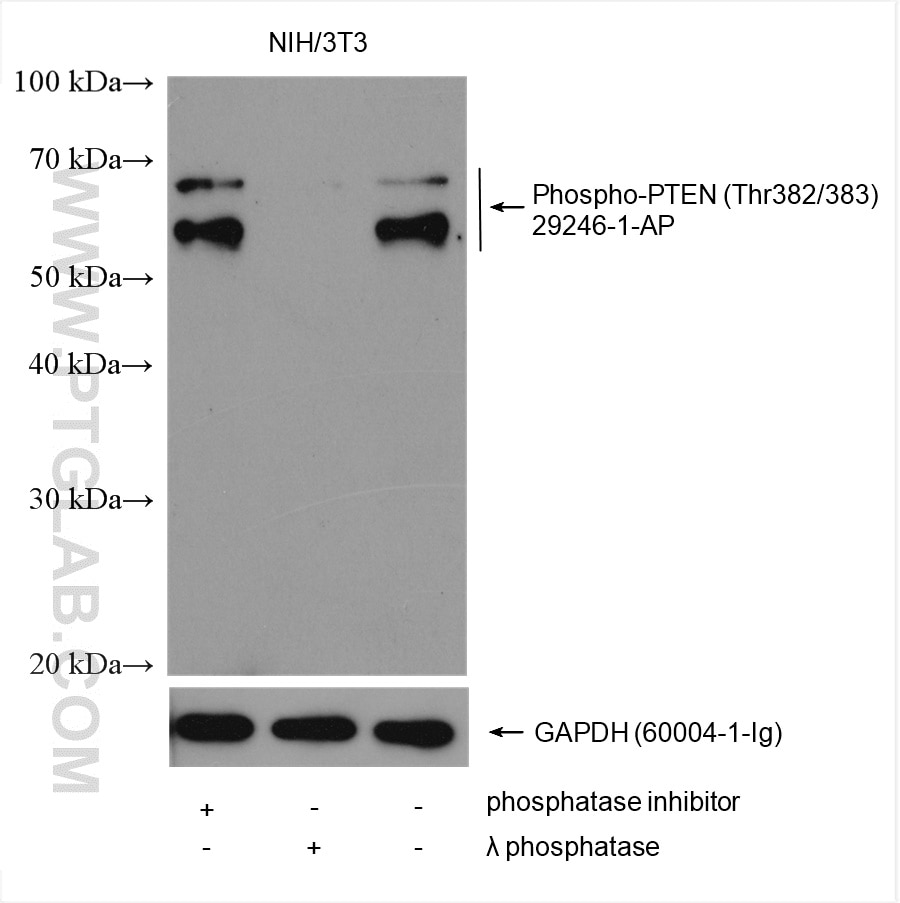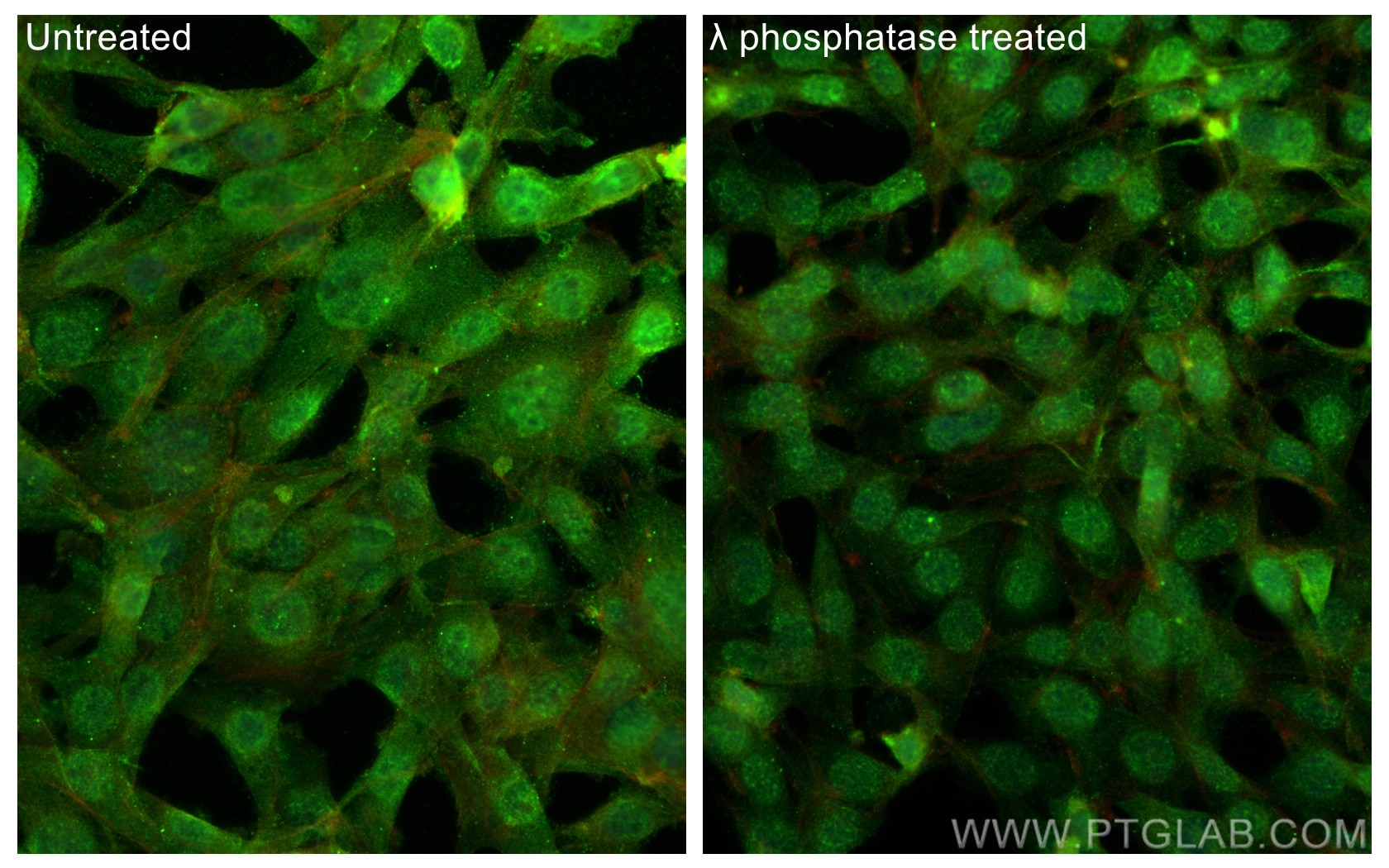Validation Data Gallery
Tested Applications
| Positive WB detected in | NIH/3T3 cells, λ phosphatase treated NIH/3T3 cells |
| Positive IF/ICC detected in | λ phosphatase treated NIH/3T3 cells |
Recommended dilution
| Application | Dilution |
|---|---|
| Western Blot (WB) | WB : 1:2000-1:10000 |
| Immunofluorescence (IF)/ICC | IF/ICC : 1:50-1:500 |
| It is recommended that this reagent should be titrated in each testing system to obtain optimal results. | |
| Sample-dependent, Check data in validation data gallery. | |
Published Applications
| WB | See 7 publications below |
Product Information
29246-1-AP targets Phospho-PTEN (Thr382/383) in WB, IF/ICC, ELISA applications and shows reactivity with human, mouse samples.
| Tested Reactivity | human, mouse |
| Cited Reactivity | human, mouse, pig |
| Host / Isotype | Rabbit / IgG |
| Class | Polyclonal |
| Type | Antibody |
| Immunogen | Peptide 相同性解析による交差性が予測される生物種 |
| Full Name | phosphatase and tensin homolog |
| Calculated molecular weight | 47 kDa |
| Observed molecular weight | 55-70 kDa |
| GenBank accession number | BC005821 |
| Gene Symbol | PTEN |
| Gene ID (NCBI) | 5728 |
| RRID | AB_2918257 |
| Conjugate | Unconjugated |
| Form | Liquid |
| Purification Method | Antigen affinity purification |
| UNIPROT ID | P60484 |
| Storage Buffer | PBS with 0.02% sodium azide and 50% glycerol{{ptg:BufferTemp}}7.3 |
| Storage Conditions | Store at -20°C. Stable for one year after shipment. Aliquoting is unnecessary for -20oC storage. |
Background Information
PTEN is one of the most critical tumor suppressors, which functions at different subcellular locations, including the plasma membrane and nucleus. The PTEN protein is located at different subcellular regions-PTEN at the plasma membrane suppresses PI3-kinase signaling in cell growth, whereas PTEN in the nucleus maintains genome integrity. At the plasma membrane, PTEN counteracts PI3 kinase signaling by dephosphorylating the potent second messenger PIP3 to PIP2. The loss of PTEN in cancer cells results in over-activation of AKT and mTOR signaling, leading to excessive stimulation of cell growth and inhibition of cell death. In the nucleus, PTEN functions in DNA repair, genome stability, and cell cycle control through associations with Rad51 and p53. PTEN stability is primarily regulated by phosphorylation of C-terminal tail domains (Thr366, Ser370, Ser380, Thr382, Thr383, and Ser385). The phosphorylation leads to a "closed" state of PTEN and maintains PTEN stability. Dephosphorylation of the C-terminal tail opens the PTEN phosphatase domain, thereby increasing PTEN activity. PTEN protein is of the apparent molecular mass expected for PTEN (55 kDa) and PTENα (70 kDa).(PMID: 33083717, PMID: 20622047, PMID: 24768297)
Protocols
| Product Specific Protocols | |
|---|---|
| WB protocol for Phospho-PTEN (Thr382/383) antibody 29246-1-AP | Download protocol |
| IF protocol for Phospho-PTEN (Thr382/383) antibody 29246-1-AP | Download protocol |
| Standard Protocols | |
|---|---|
| Click here to view our Standard Protocols |
Publications
| Species | Application | Title |
|---|---|---|
Cell Rep Activation of GPR44 decreases severity of myeloid leukemia via specific targeting of leukemia initiating stem cells | ||
EMBO Rep LINC00493-encoded microprotein SMIM26 exerts anti-metastatic activity in renal cell carcinoma | ||
J Transl Med The miR-15b-5p/miR-379-3p-FOXO axis regulates cell cycle and apoptosis in scleral remodeling during experimental myopia | ||
Phytomedicine Rosmarinic acid attenuates glioblastoma cells and spheroids' growth and EMT/stem-like state by PTEN/PI3K/AKT downregulation and ERK-induced apoptosis | ||
Apoptosis CCDC134 enhances ovarian reserve function and angiogenesis by directly interacting with INHA in a mouse model of premature ovarian insufficiency | ||
Phytomedicine Isovitexin alleviates hepatic fibrosis by regulating miR-21-mediated PI3K/Akt signaling and glutathione metabolic pathway: based on transcriptomics and metabolomics |

